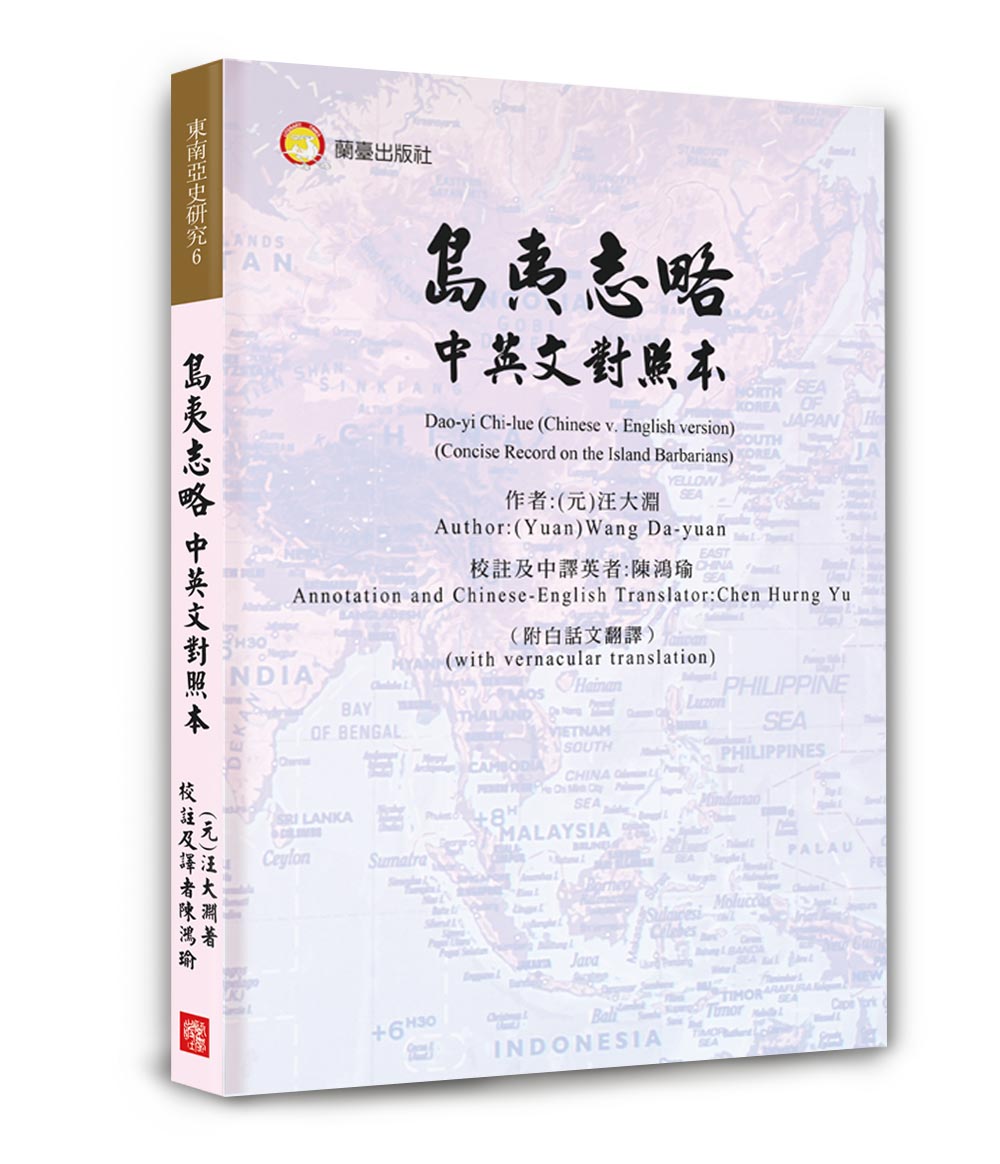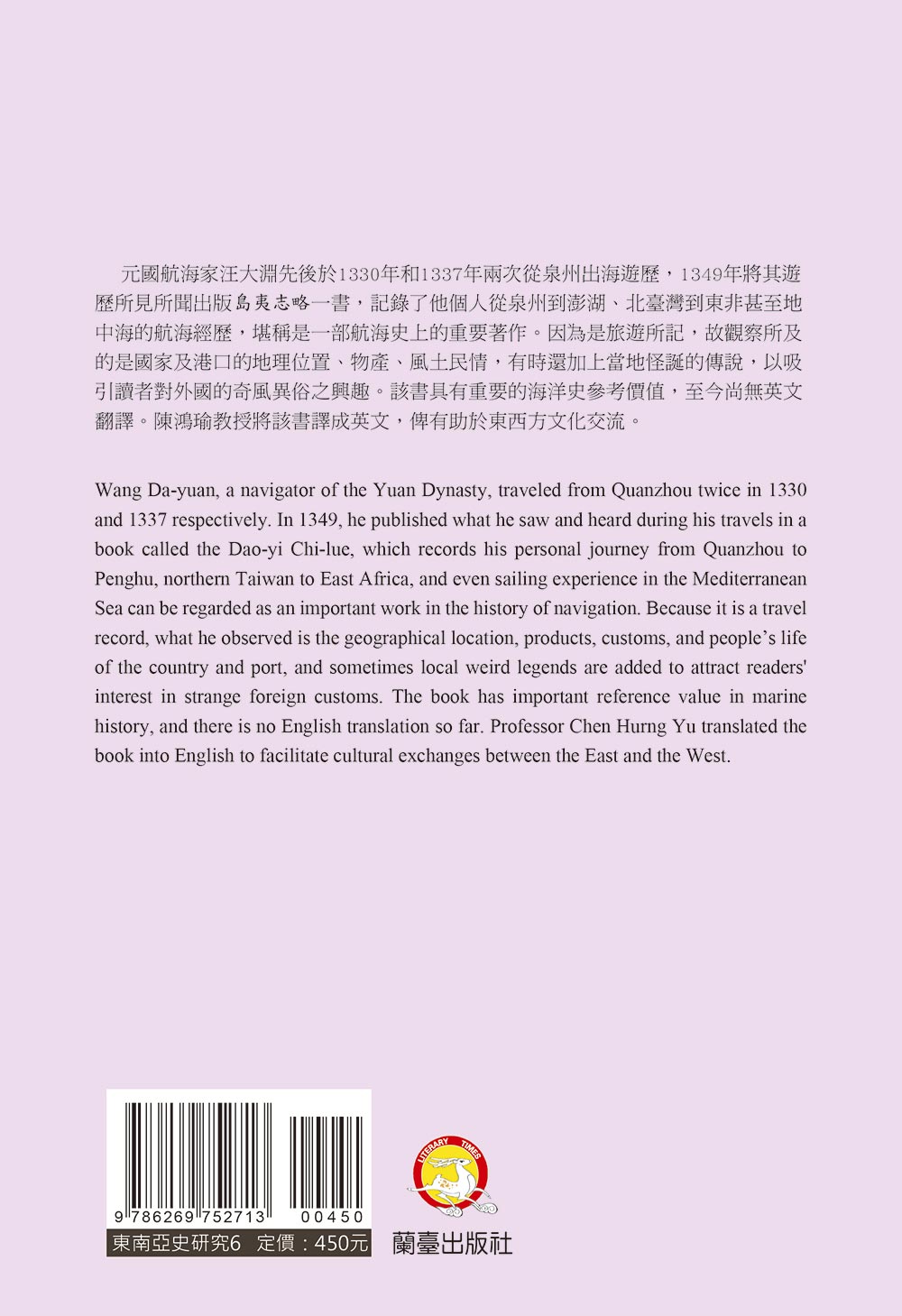島夷志略中英文對照本-出版內容簡介
元朝航海家汪大淵先後於1330年和1337年兩次從泉州出海遊歷,1349年將其遊歷所見所聞出版《島夷志略》一書,該書記錄了他個人從泉州到澎湖、北臺灣到東非甚至地中海的航海經歷,堪稱是一部航海史上的重要著作。
這本書對沿途經過東南亞各國,因為是旅遊所記,對各國家及港口的地理位置、物產、風土民情,加上當地怪誕的傳說,都加以記錄,對沿途的奇風異俗之探究是很好的參考用書。
該書具眾多各國海洋史參考資料,至今尚無英文翻譯。陳鴻瑜教授將該書譯成英文,俾有助於東亞史及東西方文化研究與交流。
Wang Da-yuan, a navigator of the Yuan Dynasty, traveled from Quanzhou twice in 1330 and 1337 respectively. In 1349, he published what he saw and heard during his travels in a book called the Dao-yi Chi-lue, which records his personal journey from Quanzhou to Penghu, northern Taiwan to East Africa, and even sailing experience in the Mediterranean Sea can be regarded as an important work in the history of navigation. Because it is a travel record, what he observed is the geographical location, products, customs, and people’s life of the country and port, and sometimes local weird legends are added to attract readers' interest in strange foreign customs. The book has important reference value in marine history, and there is no English translation so far. Professor Chen Hurng Yu translated the book into Engli
島夷志略中英文對照本-作者介紹
台灣花蓮市人
國立政治大學歷史系名譽教授
淡江大學外交與國際關係學系榮譽教授
學歷:國立政治大學政治系畢業
國立政治大學政治研究所碩士班、博士班畢業
國家法學博士(1978年)
美國喬治城大學訪問教授
新加坡東南亞研究院訪問教授
經歷:
淡江大學外交與國際關係學系教授(2017年1月31日退休)
淡江大學亞洲研究所教授
淡江大學東南亞研究所教授兼所長(2008年8月1日至2009年7月31日)
國立政治大學歷史系教授(2000年8月1日至2006年8月1日退休)
國立暨南國際大學教授兼東南亞研究中心主任(1995年8月1日至1998年7月31日)
國立暨南國際大學東南亞研究所教授兼所長(1997年8月1日至1998年7月31日)
國立政治大學國際關係研究中心研究員兼國際組召集人(1993年3月至1995年7月)
國立政治大學國際關係研究中心研究員兼國際組副召集人(1987年1月至1993年2月)
國立政治大學外交研究所、東亞研究所、中山人文社會科學研究所兼任教授
「問題與研究」月刊主編(1987年4月至1994年5月)
「東南亞季刊」發行人兼主編(1996年1月1日至1998年7月31日)
「戰略與國際研究」季刊主編(1998年8月至2000年4月)
中華民國海外華人研究學會理事長(1996年3月至2000年3月)
「海華與東南亞研究」季刊發行人兼主編(2001年1月至2004年12月)
Name: Hurng Yu, Chen (陳鴻瑜)
Current Position:
Emeritus Professor, Department of History, National Chengchi University, Taipei, Taiwan
Emeritus Professor, Department of Diplomacy and International Relations, Tamkang University
Education:PH.D, (in 1978) Graduate School of Political Science, National Chengchi University (in Taiwan)
Publications:
Political Development of the Philippines (1980)
Theory of Political Development (1982)
Sovereignty and International Conflict in South China Sea (1987)
Politics and Foreign Policy of the Southeast Asian Countries (1992)
A New Role of Taiwan In Asia-Pacific (1996)
Development of the Association of the Southeast Asian Nations (1997) Discovery, Development, and Conflict of the Islands in South China Sea (1997)
Political Democratization in Taiwan (2000)
Diplomatic Relationship between the Republic of China and Southeast Asian Nations (1912-2000),(2004)
Government and Politics in Southeast Asia (2006).
A History of Indonesia (2008)
A Modern History of Vietnam (2009)
A History of Singapore (2011)
A History of Cambodia (2015)
Compilation and Annotation of Historical Materials of the Relations between China and Southeast Asia before 1912 (2018)(4 Volumes) Territorial Sovereignty of Taiwan and Its Nearby Island (2018)
A History of Vietnam (2019)
East Asian Sea Routes and the Development of Civilization (2020)
Military Relations Between Taiwan and Southeast Asia During the Cold War(2022)
島夷志略中英文對照本-目錄
譯者序Translator’s Preface i
張序Chang’s Preface iv
吳序Wu’s Preface ix
附:淸源續志序Appendix: Preface of the Continuation of Qingyuan Chronicles xiii
譯者之導論 1
Translator’s Introduction 1
正文 9
Text 9
1.彭湖 9
1.Penghu (Pescadores Islands) 9
2.琉球 11
2.Ryukyu 11
3.三島 13
3.Sāndǎo (Three islands) 13
4.麻逸 15
4.Máyìt 15
5.無枝拔 17
5. Wú Zhī Bá 17
6.龍涎嶼 18
6. Lóng Xián Yǔ 19
7.交趾 20
7.Jiāozhǐ (Cochin) 20
8.占城 22
8.Zhàn Chéng (Champa) 22
9.民多朗 25
9.Mindorang 25
10.賓童龍 26
10.Bintonglong 26
11.眞臘 29
11.Zhen-la 29
12.丹馬令 33
12.Thammarak 33
13.日麗 35
13.Rì Lì 35
14.麻里魯 37
14.Málǐ Lǔ 37
15.遐來物 38
15.Xiá Lái Wù 38
16.彭坑 40
16.Péng Kēng 40
17.吉蘭丹 41
17.Kelantan 41
18.丁家盧 43
18.Terengganu 43
19.戎 44
19.Rong 44
20.羅衞 46
20.Luo Wei 46
21.羅斛 48
21.Luó Hú (Lopburi) 48
22.東沖古剌 50
22.Dōng Chōng Gǔ Lá 50
23.蘇洛鬲 52
23.Srokam (Kedah) 52
24.針路 54
24.Zhēnlù 54
25.八都馬 55
25.Baduma 55
26.淡邈 57
26.Dàn Miǎo 57
27.尖山 58
27.Jianshan (steep mountain) 58
28.八節那間 60
28.Bā Jié Nà Jiān(Surabaya, Surabaja) 60
29.三佛齊 61
29.Sanfoqi (Sri-Vijaya) 61
30.嘯噴 63
30.Xiào Pēn 63
31.浡泥 65
31.Bó Ní (Borneo) 65
32.朋家羅 67
32.Péng Jiā Luó 67
33.暹 68
33.Xiān (Sukhothai) 68
34.爪哇 71
34.Java 71
35.重迦羅 74
35.Chong Jia Luo 74
36.都督岸 76
36.Dūdū Àn 77
37.文誕 78
37.Wén Dàn 78
38.蘇祿 80
38.Sulu 80
39.龍牙犀角 82
39.Lóng Yá Xījiǎo 82
40.蘇門傍 84
40.Sumen Pang 84
41.舊港 85
41.Jiù Gǎng (Palembang) 85
42.龍牙菩提 87
42.Lóng Yá Pútí 87
43.毗舍耶 89
43.Pi-sir-ya(Visaya) 89
44.班卒 90
44.Bān Zú 90
45.蒲奔 91
45.Pu Ben 92
46.假里馬打 93
46.Jiǎ Lǐ Mǎ Dǎ 93
47.文老古 94
47.Wén Lǎo Gǔ 95
48.古里地悶 96
48.Gǔlǐ De Mèn (Timor) 96
49.龍牙門 98
49.Lóng Yá Mén (Lingga Island) 99
50.崑崙 101
50.Kūnlún 101
51.靈山 103
51.Língshān 103
52.東西竺 105
52.Dōngxī Zhú 105
53.急水灣 107
53.Jí Shuǐ Wān(Turbulence Bay) 107
54.花面 109
54.Huāmiàn (Flower Face) 109
55.淡洋 110
55.Dàn Yáng 110
56.須文答剌 112
56.Xū Wén Dá Lá 112
57.僧加刺 113
57.Sēng Jiā La 114
58.勾欄山 116
58.Gōulán Shān (Goulan Mountain) 116
59.特番里 117
59.Tèfān Lǐ 118
60.班達里 119
60.Bān Dá Lǐ 120
61.曼陀郞 121
61.Màn Tuó Láng 122
62.喃巫哩 123
62.Nán Wū Lī 123
63.北溜 125
63.Běi Liū(North slip) 125
64.下里 127
64.Xià Lǐ 127
65.高郞步 128
65.Gāo Láng Bù 129
66.沙里八丹 130
66.Shālǐ Bā Dān 130
67.金塔 132
67.Jīn Tǎ (Gold Pagoda) 132
68.東淡邈 133
68.Dōng Dàn Miǎo 134
69.大八丹 135
69.Dà Bā Dān 135
70.加里那 137
70.Jiālǐ Nà 137
71.土塔 138
71.Tǔtǎ 139
72.第三港 140
72.Third Port 140
73.華羅 143
73.Huá Luó 143
74.麻那里 144
74.Má Nàlǐ 145
75.加將門里 147
75.Jiā Jiàngmén Lǐ 147
76.波斯離 148
76.Bōsī Lí 148
77.撻吉那 150
77.Tà Jí Nà 150
78.千里馬 152
78.Qiānlǐmǎ 152
79.大佛山 153
79.Dà Foshān (Dà Fo mountain) 153
80.須文(達)那 155
80.Xū Wén (Da) Nà 156
81.萬里石塘 157
81.Wànlǐ Shí Táng 158
82.小㖵喃 160
82.Xiǎo Gé Nán 160
83.古里佛 162
83.Gullifo 162
84.朋加剌 164
84.Péng Jiā Lá (Bangladesh) 164
85.巴南巴西 166
85.Bā Nán Bāxī 167
86.放拜 168
86.Fàng Bài 168
87.大烏爹 169
87.Dà Wū Diē 170
88.萬年港 172
88.Wànnián Port 172
89.馬八兒嶼 173
89.Mǎ Bā Er Yǔ (Mǎ Bā Er Island) 174
90.阿思里 175
90.Ā Sī Lǐ 175
91.哩伽塔 177
91.Lī Jiā Tǎ 177
92.天堂 179
92.Tiāntáng 179
93.天竺 181
93.Tiānzhú (Hindu, India) 181
94.層搖羅 183
94.Céng Yáo Luó 183
95.馬魯澗 185
95.Mǎ Lǔ Jiàn 185
96.甘埋里 187
96.Gān Mái Lǐ 187
97.麻呵斯離 189
97.Má Hē Sī Lí 189
98.羅婆斯 191
98.Luó Pó Sī 191
99.烏爹 193
99.Wū Diē 193
100.異聞類聚 196
100.Dissimilar Cluster 196
101.島夷誌後序 200
101.Postscript of Record on Island Barbarians 200
附錄:古今地名對照表 204
Appendix: Contrast Table of Ancient and Modern Place Names 204
島夷志略中英文對照本-序/導讀
島夷志略一書應是中國人遊歷海外撰寫的第一本遊記,對遍佈東南亞、南亞、地中海南岸和東非等99個國家和城市做了簡略的介紹。其因是汪大淵個人的親身經歷,故更是珍貴。
The book Dao-yi Chi-lue should be the first travel diary written by the Chinese who traveled overseas. It briefly introduced 99 countries and cities in Southeast Asia, South Asia, the southern coast of the Mediterranean Sea, and East Africa. Because it is Wang Da-yuan's personal experience, it is even more precious.
汪大淵是江西南昌人,南昌不靠海,也不是鄉人大量外移南海諸國的僑鄉,不知何種因緣際會,讓汪大淵出洋兩次,投身大海,尋訪各國?無論汪大淵以何種身份出洋遊歷,並將遊歷所見筆記下來,傳諸後世,讓後世得窺第十四世紀時這些國家和城市的樣貌,都是值得讚揚。
Wang Da-yuan is a native of Nanchang, Jiangxi. Nanchang is not close to the sea, nor a hometown of overseas Chinese where many villagers immigrated to the South China Sea countries. I don’t know what kind of karma made Wang Da-yuan go abroad twice, devote himself to the sea, and seek to visit many vital port-city? No matter in what capacity Wang Da-yuan traveled abroad, he wrote down what he saw. He passed it on to future generations, so those future generations could have a glimpse of what these countries and cities looked like in the 14th century, which is worthy of praise.
譯者在2018年參加一次研討會,評論一篇菲律賓學者的文章,她引用島夷志略中有關三島的內容,見其英文譯文與原文意思有出入,故極思將該書譯成英文,俾讓外國人得瞭解該書的內容。
The translator participated in a seminar in 2018 and commented on an article by a Filipino scholar. She quoted the content about the three islands in Dao-yi Chi-lue. Seeing that the English translation was different from the original, at that time I hope to translate the book into English, So that foreigners can understand the content of the book.
當本書完成英文翻譯時,內人說,你翻譯古文為英文,是方便了英文讀者閱讀,但有許多中文年輕一代讀者,對古文言文不甚瞭解,你應該將之譯成白話文。所以筆者又花了些時間將文言文譯成白話文。
When the English translation of this book was completed, my wife said that you translated ancient Chinese into English, which is convenient for English readers, but there are many young Chinese readers who do not know much about ancient classical Chinese, so you should translate it into the vernacular. Therefore, I spent some time translating classical Chinese into vernacular.
于今終於譯成,願與讀者諸君分享之。
I have finally translated it today, and I would like to share it with readers.
陳鴻瑜謹誌
Chen Hurng Yu
2023年5月4日
May 4, 2023



